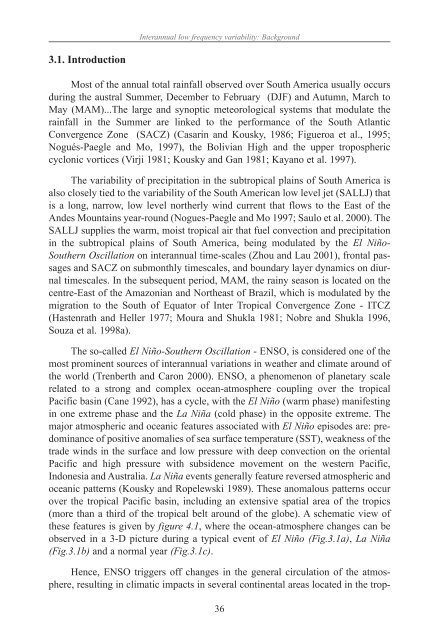chapter - Atmospheric and Oceanic Science
chapter - Atmospheric and Oceanic Science
chapter - Atmospheric and Oceanic Science
You also want an ePaper? Increase the reach of your titles
YUMPU automatically turns print PDFs into web optimized ePapers that Google loves.
3.1. Introduction<br />
Interannual low frequency variability: Background<br />
Most of the annual total rainfall observed over South America usually occurs<br />
during the austral Summer, December to February (DJF) <strong>and</strong> Autumn, March to<br />
May (MAM)...The large <strong>and</strong> synoptic meteorological systems that modulate the<br />
rainfall in the Summer are linked to the performance of the South Atlantic<br />
Convergence Zone (SACZ) (Casarin <strong>and</strong> Kousky, 1986; Figueroa et al., 1995;<br />
Nogués-Paegle <strong>and</strong> Mo, 1997), the Bolivian High <strong>and</strong> the upper tropospheric<br />
cyclonic vortices (Virji 1981; Kousky <strong>and</strong> Gan 1981; Kayano et al. 1997).<br />
The variability of precipitation in the subtropical plains of South America is<br />
also closely tied to the variability of the South American low level jet (SALLJ) that<br />
is a long, narrow, low level northerly wind current that flows to the East of the<br />
Andes Mountains year-round (Nogues-Paegle <strong>and</strong> Mo 1997; Saulo et al. 2000). The<br />
SALLJ supplies the warm, moist tropical air that fuel convection <strong>and</strong> precipitation<br />
in the subtropical plains of South America, being modulated by the El Niño-<br />
Southern Oscillation on interannual time-scales (Zhou <strong>and</strong> Lau 2001), frontal passages<br />
<strong>and</strong> SACZ on submonthly timescales, <strong>and</strong> boundary layer dynamics on diurnal<br />
timescales. In the subsequent period, MAM, the rainy season is located on the<br />
centre-East of the Amazonian <strong>and</strong> Northeast of Brazil, which is modulated by the<br />
migration to the South of Equator of Inter Tropical Convergence Zone - ITCZ<br />
(Hastenrath <strong>and</strong> Heller 1977; Moura <strong>and</strong> Shukla 1981; Nobre <strong>and</strong> Shukla 1996,<br />
Souza et al. 1998a).<br />
The so-called El Niño-Southern Oscillation - ENSO, is considered one of the<br />
most prominent sources of interannual variations in weather <strong>and</strong> climate around of<br />
the world (Trenberth <strong>and</strong> Caron 2000). ENSO, a phenomenon of planetary scale<br />
related to a strong <strong>and</strong> complex ocean-atmosphere coupling over the tropical<br />
Pacific basin (Cane 1992), has a cycle, with the El Niño (warm phase) manifesting<br />
in one extreme phase <strong>and</strong> the La Niña (cold phase) in the opposite extreme. The<br />
major atmospheric <strong>and</strong> oceanic features associated with El Niño episodes are: predominance<br />
of positive anomalies of sea surface temperature (SST), weakness of the<br />
trade winds in the surface <strong>and</strong> low pressure with deep convection on the oriental<br />
Pacific <strong>and</strong> high pressure with subsidence movement on the western Pacific,<br />
Indonesia <strong>and</strong> Australia. La Niña events generally feature reversed atmospheric <strong>and</strong><br />
oceanic patterns (Kousky <strong>and</strong> Ropelewski 1989). These anomalous patterns occur<br />
over the tropical Pacific basin, including an extensive spatial area of the tropics<br />
(more than a third of the tropical belt around of the globe). A schematic view of<br />
these features is given by figure 4.1, where the ocean-atmosphere changes can be<br />
observed in a 3-D picture during a typical event of El Niño (Fig.3.1a), La Niña<br />
(Fig.3.1b) <strong>and</strong> a normal year (Fig.3.1c).<br />
Hence, ENSO triggers off changes in the general circulation of the atmosphere,<br />
resulting in climatic impacts in several continental areas located in the trop-<br />
36






